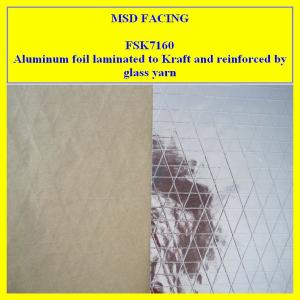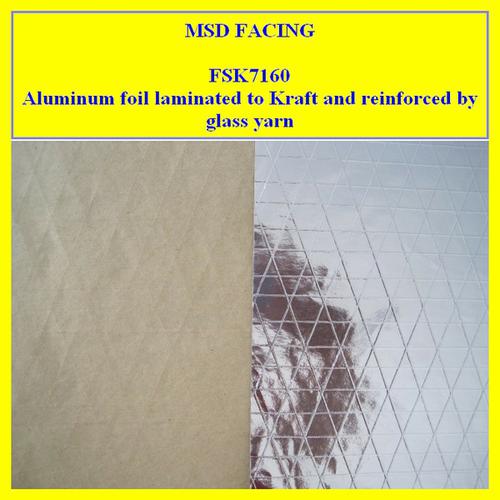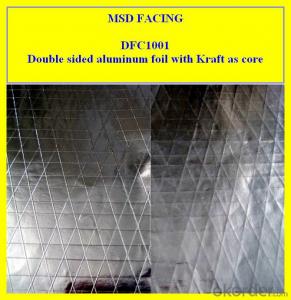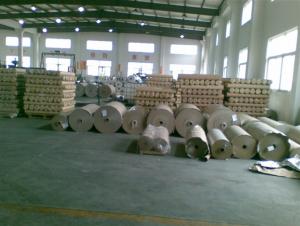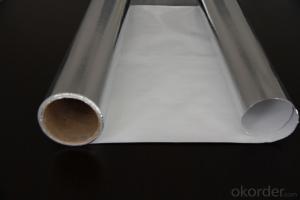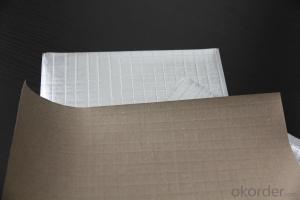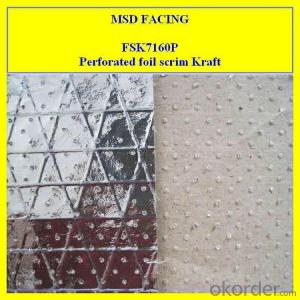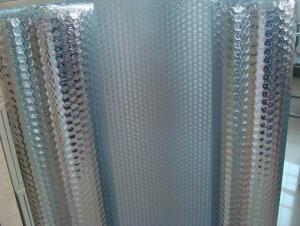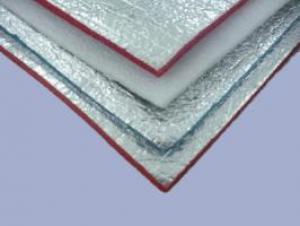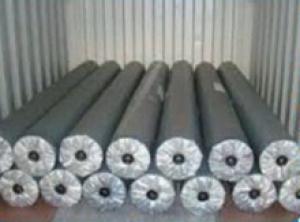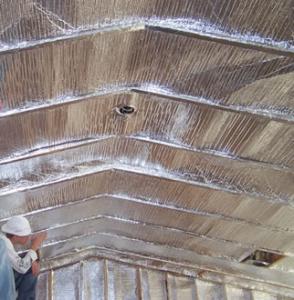Aluminum Foil Facing Single Sided Aluminium Foil Scrim Kraft Laminated Sheet
- Loading Port:
- China Main Port
- Payment Terms:
- TT OR LC
- Min Order Qty:
- -
- Supply Capability:
- -
OKorder Service Pledge
OKorder Financial Service
You Might Also Like
1. Description:
FSK7160 is the most popular laminated thermal insulation sheeting for covering ducts and pipes wrapped up by a thermal insulator such as glass wool and rock wool, PU foam and other insulation to protect them against vapor moisture in order to work more effectively, includes an reflective aluminum sheet and a fiberglass network disposed on and over a surface of the aluminum sheet
2. Construction & Benefits:
Reflective Aluminum Foil Lined With Kraft and Reinforced by fiberglass from 3 directions make this products durable.
Aluminum foil which is a good barrier to moisture, rust and the air, and friendly to environment, good conductivity from the aluminum layer eliminates the electrostatic effect easily as exposure and kraft being liner to rise the strength, they sandwiched together through polyethylene as adhesive.
l High performance cost ratio: reasonable price and professional service.
l Environment friendly: it does not contain any hazardous or harmful materials.
l Convenient to use, easy to be folded into various shapes according to actual needs.
l Better resistance and tenacity according to glass fiber within.
l Reduces heat loss in winter, heat gain in summer.
l Not effected by moisture and humidity.
l No special handling or breathing protection required.
3. Application:
It could be used as reflection, packing paper, moisture proof, radiant barrier and easy to fold as your need.
1. As a heat insulation materials in car, train, roof and wall, also been attached to glass wool blanket, rock wool board, mineral wool for get better performance.
2. A laminated thermal insulation sheeting. for covering ducts and pipes wrapped up by a thermal insulator such as glass wool and rock wool, PU foam and other insulation to protect them against vapor moisture in order to work more effectively.
3. As a sound absorber in KTV room, cinema, opera house, factory and other building.(only indicates 7160P, 7150P)
4. Package of industrial products and other place that you want to use.
4. Dimension/Size
(1) Roll width: 1000mm, 1200mm and 1250mm
(2) Roll Length: 50m, 100m, 200m, 500m, 1000m, or upon request.
(3) Core I. D.: 3"(76mm+/-1)
5. Similar products & guide
(1) DFC1001: Double sided aluminum foil supply better perfomance and function.
(2) FSK7160-P, perforate the FSK7160 as to absorb acoustic
(3) FSK7160-Tape: Applied pressure sensitive self adhesive and silicon coated paper to Kraft face, get the FSK TAPE
- Q: What distinguishes aluminum foil facing from other types of facing materials?
- <p>Aluminum foil facing is a type of facing material that uses a thin layer of aluminum, known for its excellent barrier properties against air, moisture, and light. This makes it ideal for insulation and packaging applications where preservation of contents is crucial. In contrast, other types of facings, such as paper, fabric, or plastic, may not offer the same level of barrier protection. Paper facings are often used for their aesthetic appeal and are more breathable, while fabric facings provide flexibility and are used for applications requiring durability and comfort. Plastic facings can be waterproof and are used where a shiny or smooth surface is desired. Each type of facing has unique properties that make it suitable for specific applications, with aluminum foil facing being particularly notable for its barrier capabilities.</p>
- Q: Is it possible for metal shavings to contaminate food when using aluminum foil with a shiny side?
- <p>There is minimal risk of metal shavings getting into food when using aluminum foil facing. Aluminum foil is designed to be safe for food contact and is generally resistant to shedding particles. However, if the foil is damaged or handled roughly, small particles could potentially come off. To mitigate this risk, ensure the foil is in good condition, avoid tearing it, and handle it carefully to prevent any metal contamination.</p>
- Q: Is it safe to use aluminum foil as a cooking surface? If yes, what kinds of foods are suitable for cooking with aluminum foil?
- <p>Yes, aluminum foil can be used for cooking, but it's important to use it safely. It's suitable for wrapping foods like fish, meats, and vegetables to retain moisture and flavor. It's also used for making packets for steaming or baking, and for lining baking sheets to prevent sticking. However, avoid using it with acidic foods or at high temperatures as it can react with the food or release aluminum into the food. Always use heavy-duty aluminum foil for cooking to ensure it can withstand the heat.</p>
- Q: What are the most effective ways to clean surfaces that have aluminum foil applied to them?
- <p>The best cleaning methods for aluminum foil facing involve gentle cleaning to avoid damaging the foil. Use a soft cloth or sponge with warm water and mild dish soap to wipe the surface. Avoid abrasive cleaners or scrubbing, as this can scratch or tear the foil. For stubborn stains, a mixture of baking soda and water can be applied as a paste and gently rubbed with a soft cloth. Always rinse thoroughly and dry the surface to prevent water spots and maintain the integrity of the aluminum foil.</p>
- Q: Can aluminum foil be used as a facing material to construct a sandwich?
- <p>While aluminum foil is not traditionally used as a facing material for making sandwiches, it can technically be used to wrap a sandwich for storage or transportation. However, it's not suitable for direct contact with the sandwich ingredients as it can tear or leave aluminum particles on the food, which is not ideal for consumption. Instead, use bread or other edible facing materials to construct the sandwich, and aluminum foil for wrapping it if needed.</p>
- Q: This question asks for methods to clean oil stains from the aluminum foil facing of a surface.
- <p>To remove oil stains from aluminum foil facing, start by scraping off any excess oil with a plastic scraper or a butter knife. Then, mix a solution of warm water and dish soap. Apply the solution to the stained area and let it sit for a few minutes. Use a soft cloth or sponge to gently scrub the area. Rinse with warm water and dry thoroughly. For stubborn stains, you can use a mixture of baking soda and water to create a paste, apply it to the stain, let it sit for 15 minutes, then scrub and rinse. Always test cleaning methods on a small, inconspicuous area first to ensure no damage occurs.</p>
- Q: Is it safe to use aluminum foil with a facing layer for storing salad dressings or oils?
- <p>Yes, it is generally safe to use aluminum foil facing for storing salad dressing or oil. Aluminum foil facing is designed to provide a barrier against air and moisture, which helps to keep the contents fresh. However, it's important to ensure that the foil is food-grade and that it does not have any sharp edges that could puncture the container. Additionally, it's best to store these items in a cool, dry place away from direct sunlight to maintain their quality and prevent spoilage.</p>
- Q: Is it safe to use aluminum foil with a shiny side to wrap food for grilling?
- <p>Yes, you can use aluminum foil facing to wrap food for grilling. The shiny side of aluminum foil is non-stick and is safe for use with food. It helps prevent food from sticking to the foil and allows for even cooking. However, ensure that the foil does not come into direct contact with the heat source as it may cause the foil to tear or burn, potentially releasing aluminum particles into the food. Always follow grilling guidelines and safety precautions to avoid any risks.</p>
- Q: This question asks for the method to wrap a hot pan using aluminum foil, with specific instructions on how the foil should face.
- <p>To wrap a hot pan with aluminum foil, first ensure the pan is stable and on a heat-resistant surface. Take a large piece of aluminum foil, about twice the size of the pan. Hold one corner of the foil and drape it over the pan, allowing the shiny side to face the pan. Gently press the foil against the pan, working your way around the edges to cover the entire surface. Ensure the foil is snug but not too tight to avoid tearing. The shiny side facing the pan will help reflect heat and protect the pan's surface. Be cautious while handling the hot pan and aluminum foil to avoid burns.</p>
- Q: This question asks for a comparison of various materials used for food wrapping, highlighting their unique properties and uses.
- <p>Different types of food wrap materials include plastic wrap, aluminum foil, parchment paper, and beeswax wraps. Plastic wrap is versatile, clingy, and great for sealing in freshness, but it's not microwave-safe and may not be eco-friendly. Aluminum foil is heat-resistant, ideal for cooking and sealing, but it's not reusable and can tear easily. Parchment paper is non-stick, reusable, and safe for baking, but it's not as airtight as plastic. Beeswax wraps are eco-friendly, reusable, and can be used in the oven, but they are more expensive and not as widely available. Each type has its advantages and disadvantages depending on the specific use case, such as food storage, cooking, or sustainability.</p>
Send your message to us
Aluminum Foil Facing Single Sided Aluminium Foil Scrim Kraft Laminated Sheet
- Loading Port:
- China Main Port
- Payment Terms:
- TT OR LC
- Min Order Qty:
- -
- Supply Capability:
- -
OKorder Service Pledge
OKorder Financial Service
Similar products
Hot products
Hot Searches
Related keywords
